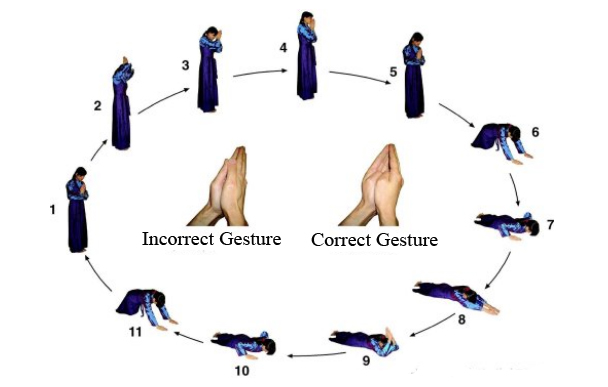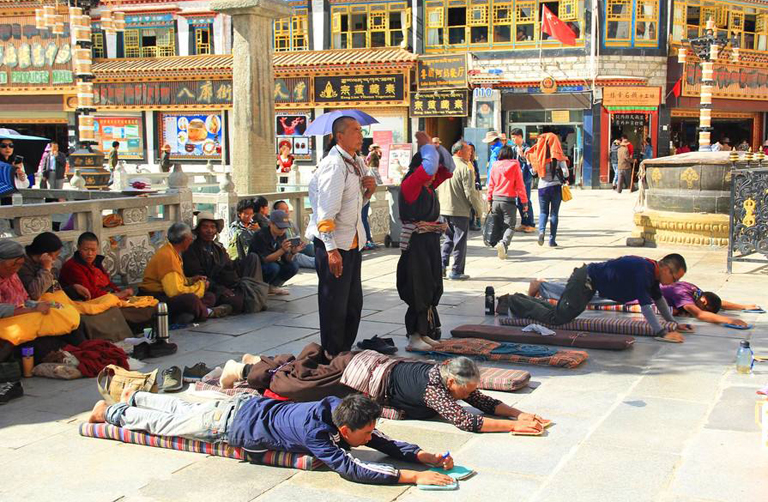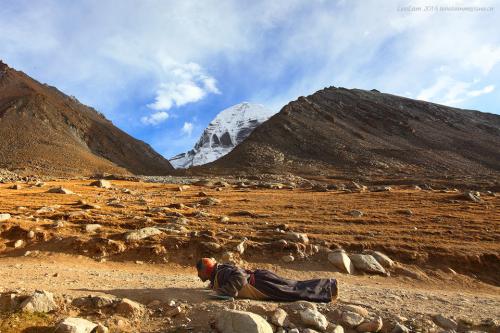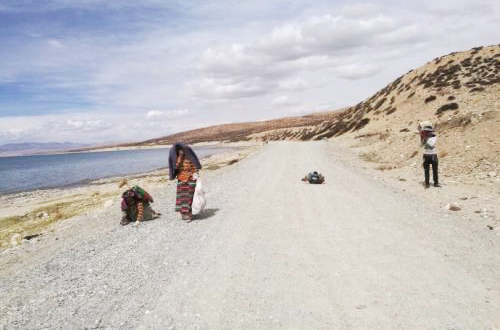Tibetan Buddhist Prostration Practice, How to Prostrate
What is Tibetan Buddhism Prostration
Tibet is a Buddhist holy land that most of the Tibetans and devoted Buddhists, so in Tibet you can see numerous Buddhists doing pilgrimage. Pilgrimage is a traditional practice to accumulate merit and good fortune. The lay practitioner might go on pilgrimage for purifying defilements and conceit, curing an illness, winning a better rebirth, ending spate of bad luck or as thanks for an answered prayer. It is practiced as a devotional exercise in by Tibetans in different methods, two most popular methods including turning prayer wheels while walking to or around the religious sites, and making prostration. Prostration has been raised to a level of particular importance in Tibet. Tibetan Buddhists believe that prostration can fully purify their mind and help them earn a better life.
Generally, prostration can be divided into three types – local prostration, short distance prostration and long distance prostration. Local prostration means prostrating without walking. There are niches for Buddha in many Tibetan families, and some people will prostrate in front of the niche every day. Some people also choose to prostrate near the holy sides – Jokhang Temple is the most crowded place to prostrate. Short distance prostration refers to prostrating around the spiritual site, like Potala Palace, Barkhor Street, Mount Kailash or some other holy monasteries. Long distance prostration is the toughest holy trip. Many pilgrims leave their remote hometown for the holy city Lhasa. They spared to stand exposure, deprivation and hunger and prostrate themselves on sediment, ice and snow. The pilgrims that you see on the highway are usually undertaking a long distance prostration. Their whole journey may take several months to several years.
How to prostrate with correct way?
 Correct Steps of Prostrating
Correct Steps of Prostrating
The correct prostrating way can be divided in to 11 detailed steps.
1. With a pray gesture, stand up facing the monastery, chapel, or the front, then put your feet together , but not too close to keep balance.
2. Keep the praying gesture and raise your hands up above your head.
3. Touch your hands down to your brown.
4. Go on touching your hands down to your nose.
5. Get your hand back to your chest and be ready for prostrating.
6. Bend your waist facing the ground.
7. Lower your body on the ground and prop on the ground as the Push Ups.
8. Stretch your arms to the front and put your hands together to make a praying gesture again. For short and long distance prostration, you need to make a sign on your hand position when your arms stretch out. Because you need to walk to the sign and begin another one after you finish this prostration.
9. Keep your legs fold and put up your forearms above your hands.
10. Withdraw your hands and prop on the ground again.
11. Then stand up and prepared for the next prostration.
Popular Buddhist Sites to Pilgrimage or Prostrate
Buddhists believe one should prostrate at least 10,000 times during his lifetime. There are several popular Buddhist sites to prostrate or kora, four most important ones are Jokhang Temple, Bharkhor Street, Mount Kailash and Lake Manasarovar.
● Jokhang Temple. As the spiritual center of Lhasa hosing the honored Life-sized Statue of Shakyamuni at his age 12, Jokhang Temple square is filled with pilgrims every day. Because pilgrims’ long times of prostration, some flagstones at the entrance of Jokhang Temple were polished. In the square of Jokhang Temple, you are able to savor the strong smell of yak butter and listen to the murmur of scriptures. Climbing up to the golden roof delivers you a marvelous view.
● Barkhor Street. Barkhor Street is the most famed pilgrim circumambulation With long streams of devoted Tibetan pilgrims walking clockwise and chanting prayers, Barkhor Street shows a thick fragrance of Tibetan Buddhist culture. Many pilgrims perform full prostrations to the hand-polished stone day and night. There are also many shops lined in Barkhor Street, many travelers also come here to appreciate Buddhist atmosphere as well as purchase some local souvenirs.
● Mount Kailash. Mount Kailash in Ngari has long been a lodestone to many religious pilgrims and adventurous travelers. It is “center of the world” worshiped by four influential religions, including Bön, Buddhism, Hinduism, and Jainism. Every year, there are countless pilgrims from different corner traveling far to kora and prostrate around Mount Kailash. In addition to its religious status, the natural view of Mount Kailash is superb. Ordinary travelers are also recommended to take a trekking along this holy mountain.
● Lake Manasarovar: Also located in Ngari, Lake Mansarovar is another hot kora place just 36 km the Darchen (the starting point of kora around Kailash). Listed in the Three Holy Lakes in Tibet, Lake Manasarovar is regarded as the mother of holy lakes. It is believed that Lake Mansarovar can purify all the evil of people. Because of close distance of Mount Kailash and Lake Manasarovar plus their religious importance, many pilgrims will take a Kailash Manasarovar Yatra.
● Other Religious Sites. Apart from these four sites, some other circumambulation is also important, including Potala Palace, Namtso Lake, Yamdrok Lake, Ramoche Temple etc.
 Pilgrims keep prostrating to Jokhang Temple
Pilgrims keep prostrating to Jokhang Temple
 One Tibet prostrated around Mount Kailash
One Tibet prostrated around Mount Kailash
 Prostrating along Lake Manasarovar
Prostrating along Lake Manasarovar
Are you a Buddhist believer or a Buddhism fan? We provide several tours to explore the Buddhist culture in Tibet and Nepal, please check following tours. If you want more, feel free to contact us and our travel constant can tailor-made a tour according to your needs.
>> 6 Days Lhasa Gyantse Shigatse Historical Tour
>> 13 Days Mt. Kailash & Lake Manasarovar Yatra Tour
>> 8 Days Nepal Buddhist Shangri-la Tour
Tibet Train Routes and Gateway Cities
- Beijing Lhasa Train
- Shanghai Lhasa Train
- Chengdu Lhasa Train
- Chongqing Lhasa Train
- Guangzhou Lhasa Train
- Lanzhou Lhasa Train
- Xining Lhasa Train
- Xian Lhasa Train
- Lhasa Shigatse Train
- Lhasa Nyingchi Train
- Yunnan Tibet Railway
- Sichuan Tibet Railway
More Information about Tibet Train
- How to Book, Collect, Alter and Cancel Train Ticket
- How to Read Tibet Train Ticket and Ticket Maps
- Change Tibet Trains at Xining Since April 19
- Tibet Train Sleeper and Seat Types
- Soft Sleeper on Tibet Trains
- Hard Sleeper on Tibet Trains
- Hard Seats on Tibet Trains
- Tibet Lhasa Train Schedule & Ticket Price
- Facilities and Amenities on Tibet Trains
- Oxygen Supply on Tibet Trains
- Medical Service in Tibet Trains
- Toilet and Bathroom on Tibet Trains
- Dining on Tibet Trains
- Tibet Train Luggage Allowance and Restriction
- How to Board & Disembark Tibet Trains
- Qinghai Tibet Railway Facts and Features
- What to see along the Qinghai Tibet Railway
- Latest News about Tibet Train
- Tibet Travel Permit and Tibet Train Travel
- Lhasa Railway Station
- Tibet Railways Map
- Tibet Train FAQs
Recommended Tibet Train Tour Packages
Check out our most popular train tour packages departing from most popular gateway cities to Tibet - Beijing,Xian, Chengdu, Xining, Shanghai, etc. All packages are customizable according to your requirements. If you have more time, you can extend your trip from Lhasa to other popular destinations, such as Shigatse, Mount Everest, Nyingchi, Ngari, etc. Check more >Tibet Train Tours
-

Lhasa
4 Days Lhasa City Private Tour - Heart of Tibet
Highlights: Potala Palace, Barkhor Street, Sera Monastery
-

Lhasa / Gyantse / Shigatse / Everest / Lhasa
8 Days Lhasa to Mount Everest Private Tour
Highlights: Potala Palace, Yamdrok Lake, Tashilhunpo Monastery, Mt. Everest
-

Lhasa / Gyantse / Shigatse / Mount Everest / Gyirong
7 Days Lhasa to Gyirong Border Overland Tour via Mount Everest
Highlights: Potala Palace, Yamdrok Lake, Palcho Monastery, Mount Everest
Have a question? Get answers from our travel experts soon!
- Your Question:
- Your Name:
- Your Email:
- Submit
 Karen
Karen Wonder
Wonder Jack
Jack Rita
Rita Johnson
Johnson Vivien
Vivien Wing
Wing Ariel
Ariel Leo
Leo Tracy
Tracy Evelyn
Evelyn April
April Phoebe
Phoebe Kelly
Kelly Shirley
Shirley Reya
Reya Juliet
Juliet Elk
Elk Karina
Karina Tammy
Tammy Felix
Felix Sean
Sean